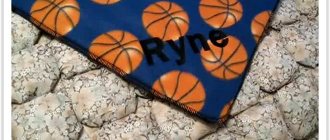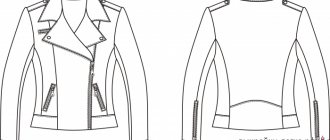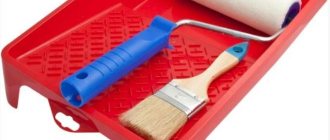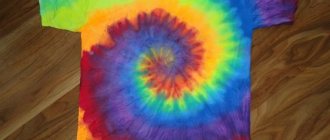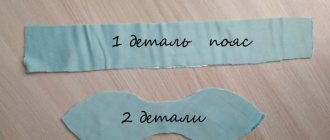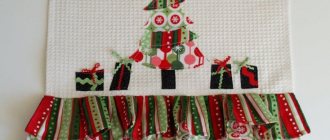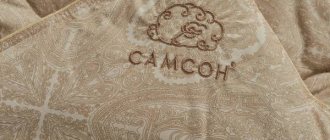The stitching of a blanket is an artistic connection of all its layers. This process is often very difficult for craftswomen, but once you get the hang of it, you can create a real masterpiece.
Stitching requires patience, meticulousness, even courage. A high-quality result depends a lot on experience and constant careful monitoring of the situation. Even experienced seamstresses can rarely quilt a blanket correctly.
You can apply a stitch pattern using a needle and thread, special adhesive tape or chalk.
However, you should not be afraid to take on such work. By following the instructions and your inner feeling, you will definitely achieve the desired result.
They usually quilt either a patchwork bedspread (patchwork technique) or a whole cotton blanket. Let's look at each option in more detail.
Stages of making a blanket using the patchwork technique
High-quality edge sealing
Machine finishing the edge of a quilt
There are many ways to create a beautiful edging, the most common is “cheesecake”.
First of all, leave a few centimeters free at the back of the bedspread; if you skipped this step, use a separate wide fabric tape. The backdrop (or tape) needs to be folded over to the front side and a seam made around the perimeter of the product, trying to get closer to the edge of the folded area.
Finishing a blanket with bias tape
We pin the corner of the edging with pins
We attach the binding, checking how the needle catches the lower half of the binding on the wrong side
Calculation of fabric for a blanket
Fabric calculations for home-made bed and duvets are largely identical, with the exception of some nuances.
Calculation of fabric for a bed blanket.
The cut width is equal to the width of the mattress, plus two depths of the mattress, plus 12.5 cm (for the overlap of the mattress and seam allowances).
The length of the cut is equal to the width of the mattress, plus the depth of the mattress, plus 7.5 cm (for the overlap of the mattress and seam allowances).
If you prefer to make your bed blanket without a ruffled border, add another 10cm to the width and 5cm to the length.
If your fabric is 229cm or 305cm wide, you may not need stitching. However, with narrower fabric, you will need to sew pieces of fabric together for the quilt. To avoid an unattractive seam in the center, it is better to make one large central section and sew two narrow ones to it on the sides. First, determine the final width and length of the bedding blanket. Then:
To make your own blanket for a double bed that has been extended in width or length, use the full width of the fabric minus 2.5 cm for the seams on both the side parts and the center part. Subtract the center section from the final quilt width. Divide the difference into two equal-width side sections.
To make your own quilt for a single bed, make a center section approximately 102cm wide plus 25cm for seams for the pieces. Subtract 102 cm from the final width of the blanket. Divide the difference into two equal-width side sections.
Now add the width of the side section, plus 5cm hem allowance, plus 12mm seam allowance; then multiply by two.
If this amount is equal to or less than the width of the fabric, then you will need two panels of fabric - one for the center, two for the sides.
If this amount is greater than the width of the fabric, then you will need three panels of fabric - one for the center and one for each side.
To sew a bed blanket the way the correct technique suggests, multiply its length (including 7.5 cm for seam allowances and overlap) by the number of panels. This will be the amount of fabric you will need for the top. You will also need the same amount of fabric for the bottom lining. For the frill, buy already assembled lace braid 10-20 cm wide. The quantity should be equal to one width and two lengths of the blanket. Or you can make your own fabric frill.
Calculation of fabric for a duvet.
The width of the cut is equal to the width of the blanket plus 2.5 cm seam allowance.
The length of the cut is equal to the length of the blanket plus 2.5 cm of seam allowance.
Refer to the instructions above to determine the width of the center and side sections, as well as the number of fabric panels. Multiply the length of the duvet (including seam allowances) plus 5cm by the number of panels. This figure will become the amount of fabric needed for the top. You will need the same amount for the lining (the bottom of the blanket).
Below are step-by-step instructions on how to sew a bed blanket with your own hands.
Photo selection of beautiful quilts using the patchwork technique, created by yourself:
PreviousTextilesWe sew a bonbon blanket
Next
Textiles How to wrap a baby in a blanket?
Styles and compositions
The most labor-intensive, but also the most valuable, are the blankets sewn from random scraps and scraps. The work took years, and to assemble this chaos in a way that would look good requires remarkable abilities. For a patchwork quilt in the style of chaos (item 1 in the figure) in England, for example, connoisseurs pay up to 8,000 pounds or more.
Most often, wedges and strips remain from cutting. The first ones naturally ask for a spiral composition (pos. 2), and the stripes are used to sew patchwork quilts in the zebra or stream style, pos. 3. The latter are valued almost on an equal basis with chaotic ones, as somewhat less labor-intensive, but more spectacular.
Photos of quilt samples
Modular
Modular (block) quilts differ from “true random” quilts in that the quilts are sewn together into geometrically regular modules, which are then trimmed to a template (see picture on the right). This simplifies and speeds up the work significantly, but the value of the product in the eyes of experts is reduced, because is determined primarily by the artistic merits of the blanket. Therefore, blocks are most often sewn square. 5-, 6-gons and other figures that are compatible without gaps greatly complicate the work, but the blanket, if it wins at all, is a little spectacular.
Trimming quilt blocks using templates
Blankets in the style of “block chaos”, pos. 4 in Fig. higher, more amateur, because their labor intensity is relatively low. At auctions in the middle price segment, block-assembled patchwork quilts in the style of arable land (pos. 5) and vegetable garden, pos. 6. They are named so because they are somewhat similar to aerial photographs of this type of area. Also average, but higher, are rated blankets in the style of a patchwork meander, pos. 7, block-geometric, pos. 8 and 9, as well as chess, pos. 10 if they are made with taste and creativity.
Note: all block quilts can be sewn so-called. reversible, with transverse, longitudinal or both seams between the blocks on the face, pos. eleven.
Patchwork
Block-modular patchwork sewing is already the origin of the patchwork technique and its variety of quilting (not to be confused with paper quilling!). In prefabricated patchwork, modules (blocks) are sewn together, as in simple patchwork, and in quilting they are sewn onto a solid base. Fundamentally, patchwork differs from simple patchwork sewing in that the patches are selected in advance and prepared for the product. For example, in patchwork kits, the patches are often already cut to size and sold in kits for a specific item, with sewing and assembly patterns attached.
Photos of blankets using patchwork technique
It is not for nothing that the patchwork technique has gained worldwide popularity: with it you can create truly masterpieces of sewing art at home in almost any national and/or traditional style; See photos for some samples. Most often, a geometric assembly of blocks of regular shape is used, but zebra, stream, wave, etc. options are also possible. Patchwork does not accept visible chaos; its pattern is always semantic and organized in a certain way. If simple patchwork is closer to abstractionism in fine art, then patchwork is already a full-fledged modernist style.
Abstract art is not without deep meaning, but in addition to an outstanding master, it also needs an equally knowledgeable viewer and connoisseur. Therefore, abstraction is easily counterfeited by empty mediocrities. Modernism is also devoid of strict canons, but it shows its essence clearly and almost everyone is able to distinguish success from worthless attempts in it. This is the second important reason for the popularity of patchwork.
Schemes and blocks
Standard patchwork block sizes are from 10x10 to 30x30 cm in increments of 5 cm. Simple patterns of patchwork blocks, such as. corner spiral and ladder, you can create it yourself on checkered paper, see figure; The numbers indicate the numbers of fabric colors according to the selected samples. The block size is obtained based on the smallest permissible width of the pattern element along the face, equal to 1.5 allowances for the hem, i.e. for most fabrics 15 mm (see below, about sewing techniques).
Simple block diagrams for patchwork
How to work with diagrams
When you search for “quilt blocks”, “patchwork blocks”, “blocks for patchwork”, “blocks for patchwork”, a lot of samples come up. But these will be either simplified diagrams with alphabetical indications of the levels (upper part in the figure), or simply samples of pattern elements (below in the figure), on the basis of which you need to develop patterns in size and arrange the available flaps according to color.
Sample blocks for patchwork sewing
The development of a complete sewing pattern using the patchwork technique is carried out in stages as follows:
- Life-size diagrams of the selected blocks are built on checkered paper;
- Fabric samples are laid out according to the diagrams until the required aesthetic effect is achieved. It is advisable to operate with all selected blocks at once, this will make it easier to achieve an overall visual effect;
- The paper blank for each block is made in the quantity necessary to sew the entire item;
- On paper diagrams, the selected colors are approximately marked with colored markers;
- Paper blanks are laid out in natural size and the overall effect is assessed;
- If some block/blocks do not fit aesthetically, repeat paragraphs. 1-3;
- When the item looks as it should, the selected blocks are numbered or designated by letters so as not to be confused with the numbering of fabric samples;
- A complete drawing of the product is drawn (for samples, see the figure below) indicating the dimensions, numbering of fabrics and blocks.
The last point is a stumbling block for beginner patchwork lovers/lovers; it is often simply overlooked. And then it turns out that “the scythe went wrong” (the mow went according to geometry and color), and it is very difficult to find where the germ of the flaw is hidden in the confusion of these seemingly simple figures.
Quilt and pillow plans
About schemes for children
Additional requirements are imposed on the development of patterns for children's things using the patchwork technique, due to the characteristics of the child's not yet fully developed vision and psyche. A patchwork baby quilt, for example, should be designed as follows:
- Large blocks are undesirable; it is better to work in a 10x10 cm module.
- Small details of the pattern should not flicker; It is advisable to avoid complex curved contours.
- Larger meaningful blocks (filled with a picture) need to be alternated with smaller background ones.
- Repetitions of the same significant block in longitudinal and transverse rows are unacceptable.
- Bright, saturated, flashy colors are also unacceptable.
- The background color in quilting should be kept in the area of greatest sensitivity of children's eyes: pale yellow, light green, pale blue.
- The symmetry of the pattern relative to the longitudinal axis is very, very desirable with an odd number of longitudinal rows, i.e. there must be a central row.
An example of the correct construction of a pattern for a children's blanket - patchwork is given in Fig. Module – 10x10 cm. Full size (170x130 cm) is designed for growth. The design of significant blocks can be different, satisfying the above requirements.
Baby quilt pattern
How to prepare wool
You can buy six already prepared for work. But if you have untreated fleece, then you need to soak it in a bathtub in warm water for several hours . When dirty, drain the water and add new water.
IMPORTANT! Do not use synthetic detergents for soaking; they can weigh down your hair.
After 1-2 days you need to wash and dry well. The fleece should be hung vertically on ropes. The best time to wash wool is on sunny summer days, so that the wool can dry naturally outside. If this is not possible, then place it in a dry and well-ventilated area.
After this, the fleece must be thoroughly beaten so that it does not lie in lumps . This is very hard and dusty work, so it is better to ask a man for help.
REFERENCE! After washing, the finished material will lose approximately half its weight.
LiveInternetLiveInternet
—Quote book
A small explanation to the post from Tanya, walking. A small explanation to the post from Tanya, walking.
Frame “Here comes summer.”
Caramel honey cake with raspberries, caramel cakes, protein cream, the sweetness of such etc.
Cartoon "Trouble in the Himalayas" online Last weekend I finally found time for...
Watch the light, funny, ironic film “Blame it on Rio.” It turned out to be a wonderful comedy.
—Photo album
—Tags
—Categories
- (0)
- iClone (1)
- Animation Shop (3)
- Catherine Deneuve (8)
- Corel (8)
- GIMP (31)
- Paint (16)
- ProShow Producer (5)
- Roberto Perry (8)
- the motions of my soul (20)
- Word - Excel (1)
- avatars (14)
- actors (45)
- alphabet (37)
- English (38)
- animations (10)
- audiobooks (55)
- famous aphorisms (1)
- banner (13)
- libraries (1)
- sparkles - blings (2)
- action games (49)
- jam (10)
- jams and compotes (6)
- video (84)
- embroidery (16)
- knitting (544)
- fortune telling (10)
- Defne gallery (86)
- gallery from Crys_tal (4)
- generators (137)
- hyphae (5)
- glitters (3)
- horoscope (4)
- Georgian cuisine (26)
- desserts (75)
- design (89)
- motorhome (1)
- animals (90)
- life of wonderful people (1)
- live healthy (9)
- blanks (9)
- snacks (193)
- curtains (4)
- toys (45)
- games (23)
- dough products (80)
- interesting sites (56)
- Art (336)
- border (1)
- Calendars (2)
- pictures (4)
- housing problem (6)
- Ceramic floristry (2)
- cinema (361)
- FS brushes (3)
- clipart (50)
- cliparts (385)
- buttons (18)
- rugs (38)
- collages (28)
- Christmas Collection (1)
- necklace, bracelets (42)
- comments in pictures (1)
- catmatrix (8)
- beauty and health (384)
- creams (12)
- dolls (23)
- chandeliers (1)
- makeup (7)
- manicure (3)
- massage (6)
- Masha and the Bear (2)
- fashion (49)
- my garden (10)
- music (105)
- drinks (71)
- nailart (4)
- wallpaper (8)
- decoration (2)
- Pates (1)
- translators (4)
- baked (425)
- booties (12)
- plugins (15)
- plaid (11)
- players (14)
- gifts (1)
- pillows (13)
- congratulations (1)
- useful for blogs (193)
- useful for computer (218)
- useful tips (22)
- parables (10)
- hairstyles (40)
- programs (430)
- weather forecast (1)
- Works and lessons from Mademoiselle (18)
- dividers (27)
- Frames (212)
- Frames from Falconet (3)
- stories (1)
- Recipes (588)
- Russian (9)
- from the diary Dreaming_Irina (3)
- gardener (14)
- salads (50)
- napkins (68)
- tutorials (1)
- series - Wolf Messing (0)
- tablecloth (31)
- download from the Internet (2)
- dictionaries (2)
- emoticons (3)
- Tips (4)
- sauces (30)
- links (97)
- FS styles (7)
- poems (45)
- bags (6)
- soups (34)
- circuits (236)
- my diagrams (4)
- Cheeses (12)
- slippers (1)
- creativity (505)
- television (22)
- dough (3)
- tests (4)
- stencils (7)
- corners (7)
- horror (2)
- patterns (7)
- decorate the table (0)
- lessons from Tatunechka (7)
- drawing lessons (142)
- cake decorating lessons (2)
- care. (1)
- porcelain (9)
- filters (13)
- Backgrounds (138)
- diary formulas (3)
- photo (86)
- FS (1226)
- flowers (23)
- quotes (6)
- famous quotes (1)
- watch (29)
- drawing templates (5)
- shawls (4)
- sewing (39)
- hats (24)
- fonts (15)
- this is interesting (186)
- this is interesting (120)
- humor (81)
—Applications
- Postcards
Reborn catalog of postcards for all occasions - Online game "Big Farm"
Uncle George left you his farm, but, unfortunately, it is not in very good condition. But thanks to your business acumen and the help of neighbors, friends and family, you are able to turn around a failing business. - I am a photographer
Plugin for publishing photos in the user's diary. Minimum system requirements: Internet Explorer 6, Fire Fox 1.5, Opera 9.5, Safari 3.1.1 with JavaScript enabled. Maybe it will work - TorrNADO - torrent tracker for blogs
TorrNADO - torrent tracker for blogs - always no analogues at hand
^_^ Allows you to insert a panel with an arbitrary Html code into your profile. You can place banners, counters, etc. there

